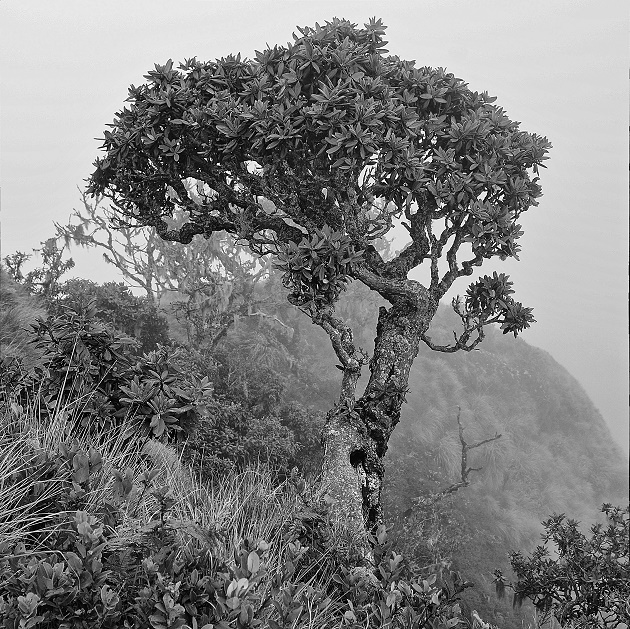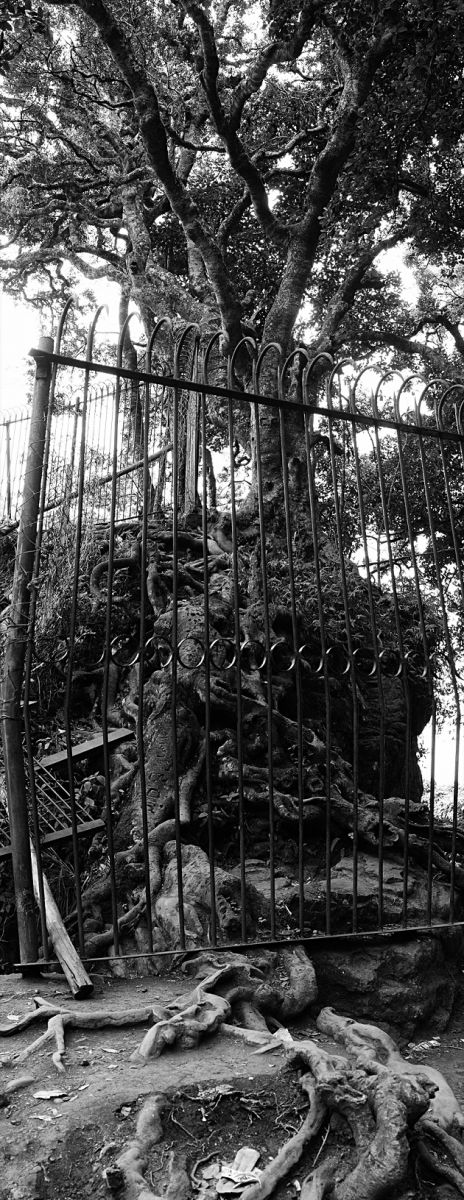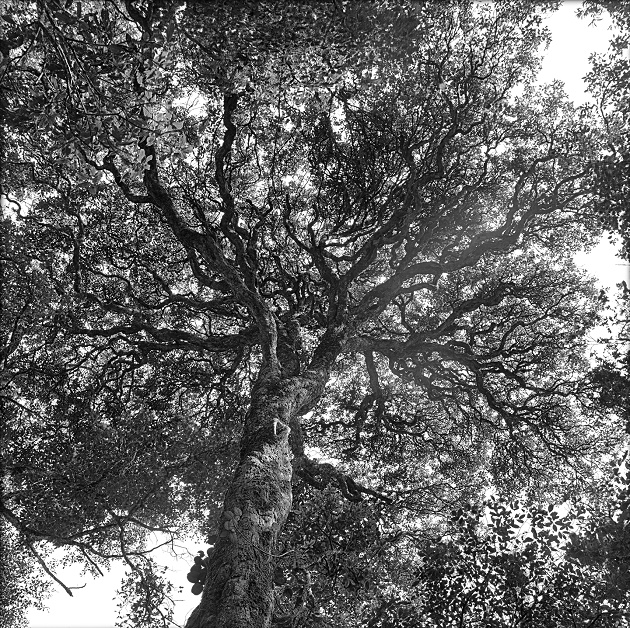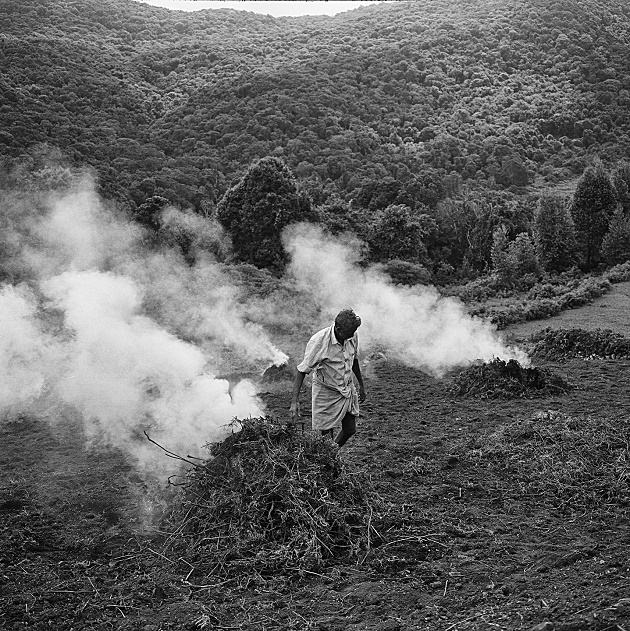The Hills of Murugan
First published in Sanctuary Asia,
Vol. 38
No. 8,
August 2018
Text and photographs by Ian Lockwood
It is July in the high reaches of the Palani Hills and a group of us is negotiating a bewildering tangle of fallen trees and vegetation that has been blown across our path by gusts from the southwest monsoon. We are a disparate group – an ecologist studying shola birds, a GIS specialist mapping grassland patches, two forest guards armed with arivaals (curved blades) and my son Lenny who has agreed to accompany us on a path that his great grandfather walked in the early 20th century. We are forced to scramble using all fours on damp moss and a bed of undecomposed leaf litter through the mess of wattle. Our destination lies ahead on a precipitous escarpment that drops dramatically from 2,500 m. in vertical granite cliffs to the dry plains that surround the edge of the lofty plateau of the Palani hills. This is one of the last corners to have escaped the plantation wave in which large areas were ostensibly carpeted with non-native timber species to replace ‘wastelands’ (grasslands) with commercially-valuable tree species.

The Rhododendron arboreum is a classic montane grasslands species and one of the only trees that is found amidst montane (above 1,800 m.) grasslands. Its thick bark helps it resist fires – a feature of the shola/grasslands that is not yet fully understood. The species illustrates important biogeographical links with the Himalaya (where it has ancestral cousins) and Sri Lanka’s Central Highlands (where the same species is found). Photo: Ian Lockwood
I have walked this same trail many times and can vividly remember a time when it was a gentle pathway through pockets of bonsai-like sholas and rolling montane grasslands. I was only 15 when our school’s three-day ‘130 km.’ trek came through this isolated corner of the Palanis. It had been raining and mist obscured the views, but when it cleared, there was little doubt that the landscape here was majestic beyond our wildest imaginations. At the time, most of our group was focused on slogging through the rain-soaked hike, avoiding pangs of hunger and nursing blistered feet. I felt those things too, but the cliffs, mist and silence of the edges evermore etched a vivid place in my memory. What we didn’t know in the 1980s was that the plantations of fast-growing Australian and Mexican timber species would soon overwhelm the same grasslands. Now, with my colleagues and son, I am following the old trails to map the last grasslands and see if we can contribute to the protection and possible restoration of the ecology of these hills.
Changes Over Time
The Palani Hills in the southern state of Tamil Nadu is named for the temple town to the north, which hosts the most important Murugan temple in India.

These montane grasslands in the Kodaikanal area have given away to urban growth as the popular tourism centre has grown. Poor enforcement of an enlightened township management plan has led to an explosion of buildings with dire consequences to natural habitats, the hydrology as well as the overall carrying capacity of the hill station.

This exquisite shola set amidst the iconic Pillar Rocks has been badly damaged by tourists as well as those trying to protect it. Haphazard iron grills have been installed in an unsuccessful effort to keep tourists from clambering over roots of the Photinia integrifolia ssp. sublanceolata or devil’s kitchen and a precipitous edge.
The hills have undergone dramatic ecological change in the last 150 years with mixed impacts on the area’s biodiversity and hydrological properties. New studies based on satellite imagery and ground observations are helping us to better understand change in this range of rugged mountains. They have shed light on the dramatic change in vegetation and land cover, its complicated (but not always disastrous) impacts and the emergence of an anthropocentric-influenced hybrid ecology in the upper hills. These changes pose dilemmas for conservationists seeking to protect the hills in an age where there are unprecedented demands on land resources for commercial development and water extraction.
The Palanis are an important range in the southern Western Ghats, the heterogeneous mountain spine that runs parallel to India’s western coast from Kanyakumari to Maharashtra’s Tapti river. The Western Ghats chain, with its mix of landscapes and different forest types is recognised for its high species endemism and the key role it plays in providing water to peninsular India.

This large-scaled pit viper Trimeresurus macrolepis in the Pambar shola is an endemic species associated with wet evergreen forests, including sholas, in the southern Western Ghats. Photo: Ian Lockwood
The fact that there is significant pressure on the Western Ghats have placed it (together with Sri Lanka) as one of Conservation International’s designated ‘hottest biodiversity hotspots’. The southern Western Ghats, including the Palani Hills, host a variety of vegetation, including lowland tropical rainforests, moist deciduous forests, dry scrub forests and the sholas/grasslands mosaic in the upper reaches (above 1,500 m.).
In the decades since independence, there were no important Protected Areas designated in the Palani Hills and the area escaped the attention of national-level conservation organisations. During the same period, aggressive plantation of non-native timber species in montane grasslands (regrettably considered to be ‘wastelands’) accelerated. The upper Palanis are now carpeted with timber plantations, which show up dramatically in satellite imagery. The impact has been complicated: there is more forest cover but it is dominated by Australian eucalyptus, Acacia and Mexican Pinus species. Wildlife populations are changing with large herbivores moving into urban environments in Kodaikanal township.

This site in the heart of the Kodaikanal municipal area has remarkable biodiversity including most of the key endemic bird species and a variety of shola tree, lianas and shrubs. Bombay Shola has several roads passing through it that allow for pleasant walks and opportunities to see birds. However, it is treated poorly and has become an illegal dump site for garbage by passing tourists and unscrupulous local businesses. Photo: Ian Lockwood
Native shola species are regenerating in many of these plantations – a potentially positive impact though different from what was originally in place. Species dependent on the montane grasslands such as the endemic Nilgiri Pipit Anthus nilghiriensis and Nilgiri tahr Nilgiritragus hylocrius are vulnerable to these changes. The hydrological impact of plantation cover in the Palanis is not well understood but studies from the Nilgiris Hills have shown significant decline in water after non-native timber plantations replaced montane grasslands. This reminds us of the Palani Hills Conservation Council (PHCC) adage “the health of the hills is the wealth of the plains.”
After several hours of hiking through plantation-dominated systems our group arrives at the edge of escarpment. We have more or less uninterrupted views back across the plateau towards Berijam and Kodaikanal. We can see multiple layers of dense growth of plantations – the tall eucalyptus, the wave patterns of pine trees and the yellow-flowered wattle are visibly distinguishable.

Montane grasslands on the windy slopes of Perumal Malai, the distinctive hat-shaped peak of the Palani Hills, survives amongst a plantation of non-native Eucalyptus sp. plantation. This is an area ripe for ecological restoration where thinning of the trees would allow a return of the grassland habitat. Photo: Ian Lockwood
There is a large marsh below us but the pine trees are creeping up beyond its edges into the middle. To the south, the cliffs of the escapement leave the group spellbound. They fall in dizzying, knife-sharp edges of granite into the deep valleys below. There are pockets of sholas that fill the valleys right from the top down to several hundred metres of the valley floor. On past trips I have observed Nilgiri tahr bounding along these same, seemingly-inaccessible cliffs. Yet, this time I am alarmed at the invasion of the upper grasslands by pine trees. Their distinct Christmas tree silhouettes emerge from the steep ridge of montane grasslands and they clutter the rim of the escarpment – far beyond the areas where they were originally planted. I observed dramatic change here; change since I last visited, change since I wrote about this very place in Sanctuary Asia magazine 15 years ago and dramatic change since my grandfather’s generation walked the hills in the early 20th century. The good news is that there is still a chance to reverse this invasion at this sublime location. In fact, the Vattakanal Conservation Trust, headed by Bob Stewart and Tanya Balcar, led a team here and spent several weeks weeding invasive species from the grasslands. Our observations give fresh impetus to our team and we return to our campsite with the sobering realisation that our study must be more than an academic exercise, that it must be linked to addressing the unexpected change to conserve and protect the last of the montane grasslands of the Palani Hills.

Agricultural practices and an increase in area of land under cultivation threaten the fragile shola/grasslands mosaic of the upper Palani Hills. Together with expanding unsustainable tourism and plantation spread, clearing fields for agriculture as seen here below the Kukkal shola is a challenge that ecosystem managers must deal with. Photo: Ian Lockwood
Mapping Montane Grasslands
An alarming conclusion of our study is the great extent to which the montane grasslands have been taken over by non-native trees and weeds. Those of us who have been walking in the hills have had a sense of this but the satellite images provide damning proof. It is clear that the plantations have spread far beyond the original boundaries than they were originally designed to be in. Most of the southern escarpment has a fire-line etched into its grasslands and now plantation species are spreading beyond this boundary and down the steep slopes of montane grasslands. This leads to a clear conclusion – efforts need to be made to save these last-remaining vestiges of montane grasslands. The challenge is that, in spite of the surprising resilience of shola tree species, the last montane grasslands are being steadily consumed by plantation (and even some shola) species.
The images and text in this article are derived from the exhibition at Chennai’s Dakshinachitra entitled The Hills of Murugan: Landscape, Ecology & Change in the Palani Hills. The exhibition is a compilation of nearly 30 years of documentation and 48 years of experience exploring in the Palani Hills. This exhibition highlights themes of changing landscape and vegetation patterns in the Palani Hills, as seen in photographs and satellite imagery.
Recommendations Based on the Study
Identify and conserve core grasslands: Core grassland areas consist of a few to many hectares of land encompassing hillocks, streams, marshes and rock outcrops. These areas, even when nestled in a plantation matrix, should be protected and form the core around which grassland restoration efforts should focus.
Check invasion in sparsely-invaded grasslands: These areas are often characterised by young plantations located in grasslands where grass cover is still extensive. We recommend physical removal of invasive species. Forest Departments often have access to significant funding through the Compensatory Afforestation (Bill passed in 2016) funds and these could be utilised for these activities as well as for restoration of marshes, existing grasslands and management of invasive plantations.
Review indiscriminate removal of mature plantations: These often have native shola forest regenerating under them and lack native grass cover. Grassland restoration of mature plantation is likely to be resource-intensive. Conservation efforts should focus on sparsely-invaded and pristine grasslands. In mature plantations, we recommend conducting experimental or controlled studies (like at Vattavada, Munnar in Kerala), perhaps also examining the role of fire, and monitoring soil and moisture conditions in these areas. Moreover, removal of mature plantations could stimulate regeneration of plantation species from saturated soil seed banks. Monitoring of these areas is important to assess the effectiveness of plantation removal.
Contain agriculture: Our field surveys indicate that paddy cultivation has been discontinued in some marshes. Given the critical role of these marshes in regulating local hydrology, efforts should be made to contain agriculture to the current extent and restore these marshes using a community-led conservation effort.
Our grasslands mapping project’s goal was to better study and quantify the ecological changes in the Palani Hills. This important work represents the combined efforts of several disparate individuals, organisations and funding agencies. The preliminary visual assessment of Landsat imagery showed that satellite data held spatial evidence of dramatic land cover change in the Western Ghats and Palani Hills but that it needed to be quantified. Robin Vijayan of Indian Institute of Science Education and Research (ISER), Tirupati, put into motion a study in 2016 with key fieldwork and spatial analysis being done by M. Arasumani and Danesh Khan. Further academic guidance was provided by Arundhati Das, Milind Bunyan and several others. Bob Stewart and Tanya Balcar of the Vattakanal Conservation Trust provided key insights on shola regeneration in plantations – the topic that originally brought everyone together. Indian National Trust for Art and Cultural Heritage, ISER, and Tirupati, helped provide funding for the field work. The Tamil Nadu Forest Department was an important stakeholder and helped provide permissions for the field work. Prasenjeet Yadav joined the project to document the work and produce a video of the findings. The study was peer-reviewed and published in January 2018. It is publicly available on PLOS One, including access to all the tables of data and charts.
Author: Ian Lockwood








